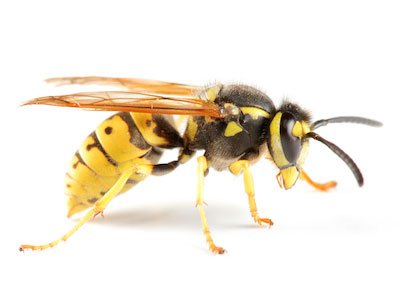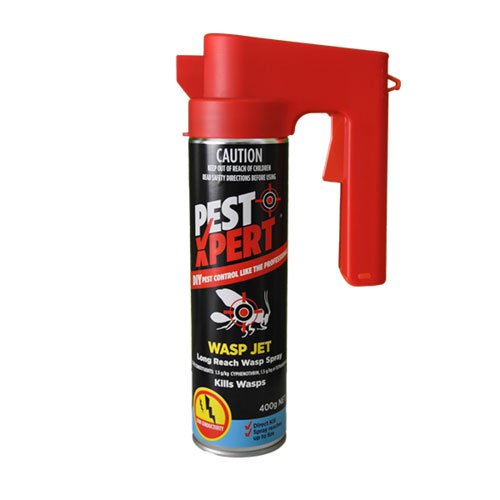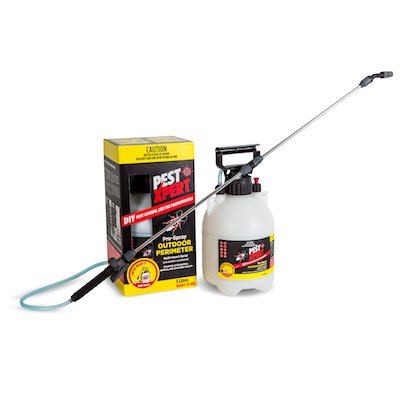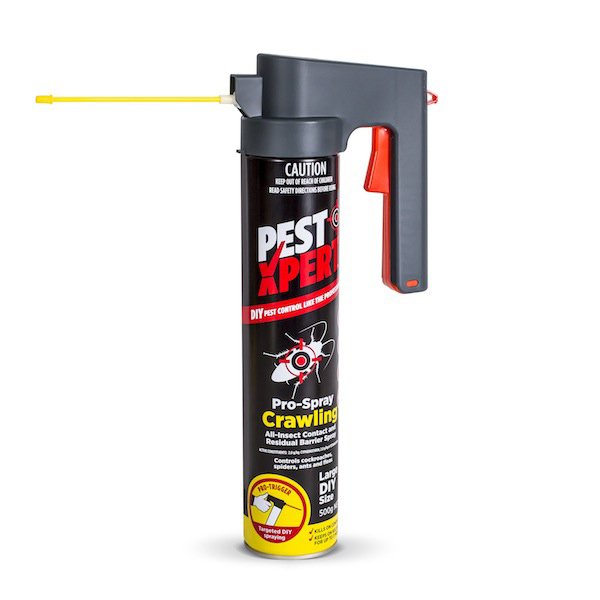How to get rid of & control wasps
Fortunately it is not a common issue, but if you have a wasp problem it can be a major concern. Wasp stings hurt and they can be dangerous! Preventing wasps building nests in the first place is the best form of control and can be achieved quite easily with some good home maintenance and the correct wasp control products. Due to the safety concerns, wasp nest removal can be a lot more difficult. However, with the new PestXpert Wasp Jet Long Reach aerosol, homeowners can tackle wasp nests with confidence.
However, safety should always be your first concern and if you are not confident in dealing with it yourself, call your council or a professional, especially if you suspect you may have European wasps.

PAPER WASP

EUROPEAN WASPS
WASP IDENTIFICATION
WHAT DO WASPS LOOK LIKE?
There are a number of wasp species in Australia. They all have a similar appearance; large insects with a narrow “waist”, an abdomen that narrows to a point (this is where the sting is!) and have warning colourations (red, yellow and black).
There are three main types of wasp in Australia:
- Paper wasps: Build nests from eaves, the underside of branches and leaves. Nests are normally quite small (maximum 100-200 wasps) and hang by a stalk. They tend not be aggressive, only stinging when defending their nest. Size: up to 2.5cm
- Mud-daubing wasps: These are large solitary wasps than build a small nest consisting of a number of cells made of mud, often plastered to the wall or ceiling. Paralysed prey (normally a spider or caterpillar) is placed in each cell before laying an egg and sealing the cell. They tend not to be aggressive, only stinging when defending their nest.
- European wasps: These bright yellow and black striped wasps are capable of forming very large nests of up to 100,000 individuals! The majority of nests are found in the ground (80%), often visible only by a hole (with wasps flying in and out), with the remainder of nests found in buildings (roof spaces, wall voids and eaves). They also build nests under exposed compost heaps. The nest consists of a number of cells forming combs (similar to a honey bee), although they are not often visible as the nest is covered by a protective paper covering. European wasps and their close relatives, the English wasp (which is also found in Australia), are not aggressive to humans unless disturbed. If disturbed they can be very aggressive, many wasps can attack at the same time, delivering multiple stings. Size: 1 – 1.5cm.
The type of wasp nest can also help in identification.
SIGNS OF AN INFESTATION
- Signs of a paper wasp nest is normally the observation of a nest hanging off the eaves or a plant.
- European wasp nests are sometime harder to locate. If you see wasps around, check your property for nests as they generally only travel 50 – 250m from the nest.
MAIN PEST SEASON
- Paper wasps will be present all year round although they tend to be more active and build their nests when the temperature warms up in Spring.
- European wasps are only found in the more temperate climates; Southern NSW, Victoria, South Australia and Tasmania. Whereas their activity reduces during the cooler months, in the warmer areas they can remain active all year round (which is why their nests can get so large).
WASP FACTS
- European wasps are native to Europe are only found in the more temperate climates; Southern NSW, Victoria, South Australia and Tasmania. The warmer parts of Australia are too warm. However, the cooler parts of Australia still have warmer Winters than Europe and so the wasp nests continue to grow during Winter (when in Europe they die back in the cold).
- Paper wasps mainly feed on protein, capturing caterpillars for their young
- European wasps eat protein (meat) but also are highly attractive to sugar foods. Wasps around rubbish, picnic areas and especially soft drink cans are a major problem.
- Single wasp stings can normally be treated by a cold pack and pain killers if required. However, if you suffer from allergies or receive multiple stings you should seek medical help immediately.
WASP PREVENTION TIPS
- Trim back bushes and over-hanging branches from the perimeter of your home.
- Carry out regular inspections of the perimeter of your building and gardens for wasp activity and signs of early nest building, especially in Spring.
- In European wasp areas, ensure rubbish bins are closed and food is not left unattended. Also make sure that any composting is carried out in containers.
WASP CONTROL TIPS
- To target individual wasps, standard aerosols are the best form of wasp killer. Make sure the wasp gets a good dose and leave the area – they tend to get angry when sprayed!
- To prevent wasps building nests around on the outside of your home, spray the perimeter of your home (especially the eaves) with insecticide. Normally a ready to use pump pack is best suited for the job.
- For direct treatment of nests, spray with PestXpert Wasp Jet Long Reach aerosol. (See safety considerations below).
PESTXPERT WASP PRODUCTS
- PestXpert Pro-Spray Crawling and Pro-Spray Flying are good options to target the occasional wasp that flies in the home, although actually Pro-Spray Crawling provides the fastest performance due to its high solvent level.
- For treating exterior surfaces to prevent wasps building nests, Pro-Spray Indoor and Outdoor and Pro-Spray Outdoor Perimeter will give lasting protection. The 1m wand on Pro-Spray Outdoor Perimeter will allow high places such as eaves to be reached safely.
- For direct nest treatment use PestXpert Wasp Jet Long Reach aerosol. With a spray range of up to 6m and high volume output, nests can be coated with insecticide quickly, from a distance.
SAFETY CONSIDERATIONS: For direct treatment of nests can be dangerous, especially for European wasps due to their aggressive nature. In addition European wasps often build their nests underground, which makes it difficult to make sure you hit the nest with the insecticide. You may not know the size of the nest, especially if it is underground, making it difficult to know how much insecticide to use. As such it is recommended that PestXpert Wasp Jet only to be used against exposed, above ground wasp nests such as paperwasp nests or small European wasp nests.
To spray a wasp nest, spray in the evening or at night – all the wasps should be in the nest and they will be calmer (until you spray!). Make sure you have suitable safety clothing on and have a quick escape route (standing on a ladder is not a good idea). When you spray the nest, make sure you spray to excess, coating the whole nest and as many wasps as possible. If you are at all unsure, contact your local council or a pest professional.





